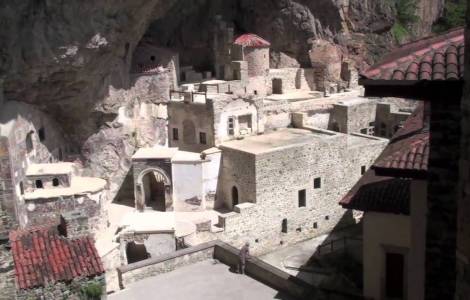
orthodoxie.com
Trabzon (Agenzia Fides) - The ancient Monastery of Sumela, located in the province of Trabzon and closed for years to visitors because it has undergone demanding restoration works, was used as a setting to create an electronic music video that saw the involvement of a team of thirty people including choreographers, musicians, DJs and dancers. The historic area of the Monastery was invaded by music reproduction and film recording systems.
The episode, which saw the ancient monastery transformed into a sort of electronic music disco - reported Turkish media – apparently took place with the authorization of local political authorities, including the provincial directorate of culture and tourism. After the spread of the news, the Ecumenical Patriarch of Constantinople, Bartholomew I, phoned the Minister of Culture and Tourism Mehemet Nuri Ersoy to ask for clarification on the matter. An investigation was launched by the Turkish Ministry of Culture and Tourism itself in order to identify the political responsibilities of an abuse that would have occurred without authorization from the government department itself.
The Monastery of Sumela, despite the poor condition in which it is located, is a place dear to the memory of Orthodox Christians. The building stands out in the middle of the mountain and is reached following a steep path. An ancient tradition - explain the guides on the memories and Christian places scattered in the Anatolian Peninsula - traces the foundation of the Monastery (today called Meryemana Manastırı, that is the Monastery of Mother Mary) to the Greek monks Barnabas and Sofronio, who arrived in that place in 385 after Christ, at the time of Emperor Theodosius I, following the indications received during an apparition of the Virgin Mary. The two monks - add the ancient traditions - carried with them an icon of the Virgin attributed to the evangelist Saint Luke. The place chosen to found the Monastery was a high rock that rose above a stream rich in water in the Pontic Alps.
The position and the fortifications built over time made the Monastery inviolable for the following centuries. In 532, returning from one of his campaigns against the Persians, the Byzantine Emperor Justinian gave the Monastery a silver urn to collect the relics of St. Barnabas.
With the conquest of Trebizond (today's Trabzon) by Fatih Mehmet II, the Ottoman Sultan who had put an end to the Eastern Roman Empire, the Monastery did not suffer particular damage, and remained for centuries a settlement of Christian monastic life in the Ottoman Empire, up to the last events of the First World War and the Greek-Turkish war: the monks left the monastery definitively only in 1923. After decades of looting and abandonment, the Turkish authorities have started the restoration aimed at protecting the site as an archaeological-monumental complex of cultural importance, and only rarely granting permission to celebrate liturgies in that place dear to the Byzantine monastic tradition. (GV) (Agenzia Fides, 10/2/2022)